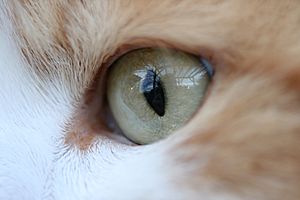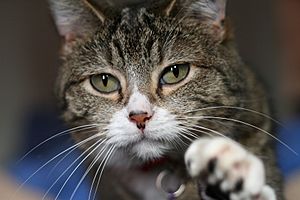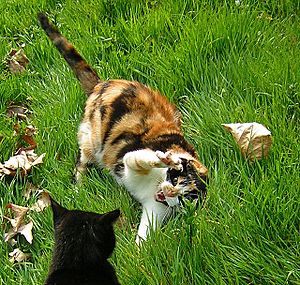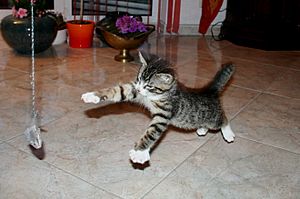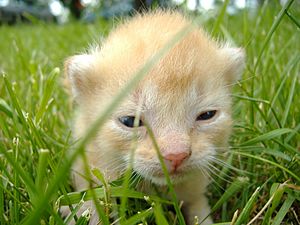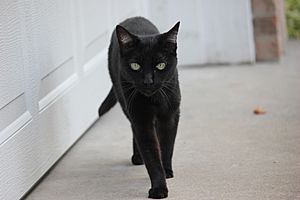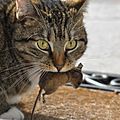Cat facts for kids
Quick facts for kids CatTemporal range: Pleistocene – Recent
|
|
|---|---|
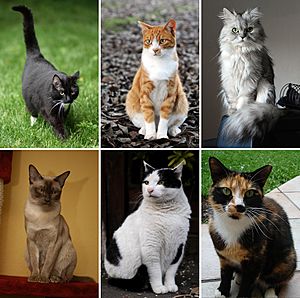 |
|
| Conservation status | |
| Scientific classification | |
| Kingdom: | |
| Phylum: | |
| Class: | |
| Order: | |
| Family: | |
| Genus: | |
| Binomial name | |
| Felis catus (Linnaeus, 1758)
|
|
Cats, also called domestic cats (Felis catus), are small, carnivorous (meat-eating) mammals, of the family Felidae. Domestic cats are often called house cats when they are kept as indoor pets. Cats have been domesticated (tamed) for nearly 10,000 years. Domesticated cats who live on farms to keep rodents away are called farm cats. Feral cats are domestic cats that live away from humans. Cats are one of the most popular pets in the world. They are kept by humans for hunting rodents and for companionship. There are about 60 cat breeds. Domestic cats are found in shorthair, longhair, and hairless breeds. Cats that are not specific breeds can be referred to as 'domestic shorthair' (DSH) or 'domestic longhair' (DLH).
A young cat is called a kitten. Cats are sometimes called kitty or pussycat. An entire female cat (able to have kittens) is a queen, and an entire male cat (able to father kittens) is a tom.
The word cat is also used for other felines. Felines are usually called either big cats or small cats. The big, wild cats are well known: lions, tigers, leopards, jaguars, pumas, and cheetahs. There are small, wild cats in most parts of the world, such as the lynx in northern Europe and the bobcat in North America. Wild cats, no matter their size, are not tame and can be very dangerous.
Contents
History
In the past, especially in Egypt, people kept domestic cats because they hunted and ate mice and rats. The oldest evidence of cats kept as pets is from the Mediterranean island of Cyprus, around 7500 BC. Ancient Egyptians worshipped cats as gods, and often mummified them so they could be with their owners "for all of eternity."
Cat Anatomy
Cats have anatomy similar to the other members of the genus Felis. The genus has extra lumbar (lower back) and thoracic (chest) vertebrae. This is why a cat's spine is so flexible. Unlike human arms, cat forelimbs are attached to the shoulder by free-floating clavicle bones. These allow cats to pass their body through any space through which they can fit their heads.
The cat skull is unusual among mammals because it has large eye sockets and a powerful and specialized jaw.
Compared to other felines, domestic cats have narrowly spaced canine teeth. This is an adaptation that helps them eat their prey of small rodents.
Cats have excellent night vision and can see things in very low light compared to humans. This is partly the result of cat eyes having a tapetum lucidum, which reflects any light that passes through the retina back into the eye, increasing the eye's sensitivity to dim light. They have an extraordinary sense of smell and sharp hearing.
To aid with traveling and feeling, cats have dozens of movable whiskers (vibrissae) over their body, especially on their faces. These whiskers tell the cat how the passageways they travel are and the location of objects in the dark. The whiskers sense air currents and objects that they touch. Whiskers also cause the blink reflexes to protect the eyes from damage, much like a human's eyelashes do.
Cats walk very precisely. Unlike most mammals, when cats walk, they use a "pacing" gait (walking style): they move the two legs on one side of the body before the legs on the other side. As a walk speeds up into a trot, a cat's gait will change to be a "diagonal" gait, similar to that of most other mammals: the diagonally opposite hind and forelegs will move at the same time. Cats, like dogs, walk directly on their toes, with the bones of their feet making up the lower part of the leg.
Most cats have five claws on their front paws and four on their rear paws. They have protractible (able to be extended) and retractable (able to be pulled in) claws. In their normal, relaxed position, the claws are sheathed with the skin and fur around the paw's toe pads. Cats may extend their claws for hunting, self-defense, climbing, kneading, or for extra traction on soft surfaces.
On the inside of the front paws, there is something that looks like a sixth "finger." This special feature on the inside of the wrists is the carpal pad. The carpal pad is also found on other cats and on dogs.
Behavior
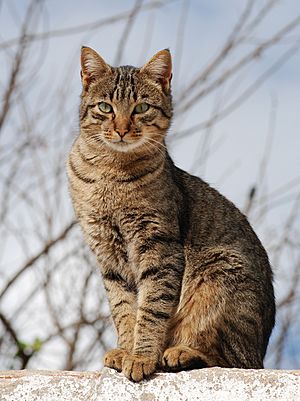
Cats are active carnivores, meaning that in the wild they hunt live prey. Cats are extremely fast, but only over short distances. Their main prey is small mammals (like mice). They will also stalk, and sometimes kill and eat, birds. Cats eat a wide variety of prey, including insects such as flies and grasshoppers. Their main method of hunting is stalk and pounce. The basic cat coat coloring, tabby (see top photo), gives it good camouflage in grass and woodland. The cat creeps towards a chosen victim, keeping its body flat and near to the ground so that it cannot be seen easily until it is close enough for a quick dash or pounce. Cats, especially kittens, practice these instinctive behaviors in play with each other or on small toys.
Cats can fish. They use a flip-up movement of a front paw which, when successful, flips the fish out of the water and over the cat's shoulders onto the grass. Dutch research showed this to be an innate (inherited) behavior pattern that cats naturally do without being taught.
Cats are quiet and well-behaved animals, making them popular pets. Young kittens are playful. They can easily entertain themselves with a variety of store-bought or homemade toys. House cats have also been known to teach themselves to use lever-type doorknobs and toilet handles. With cats, there is a limit to how far you can train them. They can be as intelligent as dogs, but they are not pack animals.
Cats are fairly independent animals. They can look after themselves and do not need or want as much attention as dogs do.
Kittens play endlessly. It is how they do their learning. They will play their favorite games, such as 'hide and pounce,' with almost anyone or anything. Soft balls on strings are a standard toy; so is a scratching post.
Communication
Cats use many different sounds for communication, including meowing, purring, trilling, hissing, growling, squeaking, chirping, clicking, and grunting.
Body posture can be used for communication as well. The position of its ears and tail tell other cats what a cat wants to say. The whole shape of the body changes when a cat is relaxed versus when it is alert.
These ways of communication are very important. They are used between a mother cat and her kittens. They are also used between male and female cats; and between cats and other species, such as dogs. A mother cat protecting her kittens will fight off the largest dog. She gives a good warning with a frightening display, hissing furiously, showing her claws, arching her back, and making her hair stand on end. If that fails, she attacks the dog's face with her claws. It has been said that no dog ever tries to attack a second time.
Reproduction
The gestation period for cats is about two months, with an average length of 66 days. The size of a litter is usually three to five kittens. Kittens are weaned at between six and seven weeks, and cats normally reach sexual maturity at 5–10 months (females) and 5–7 months (males). Females can have two to three litters per year and can breed for about 10 years. This means a female cat could have up to 150 kittens in her lifetime.
Pregnant females deliver their litters by themselves, guided by instinct. They find the safest place they can. Then they will clean it thoroughly, with their tongues, if necessary. Here they will quietly give birth.
Kittens that are born in a home should not go out of the house until they are two to three months old.
Grooming
Cats are incredibly clean animals. They groom themselves by licking their fur. The cat's tongue can act as a hairbrush and can clean and untangle a cat's fur. Still, owners may buy grooming products to help the cat take care of itself. After licking their fur, cats sometimes get hairballs. A hairball is a small amount of fur that is vomited up by animals when it becomes too big. This is quite normal. Owners brush their cats to try to prevent as many hairballs as possible.
Food
Today, special food for cats is widely available in developed countries. Many house cats eat food that their owners give them. This food is manufactured and designed to contain the right nutrients for cats. Proper feeding will help a cat live longer compared to hunting or being fed table scraps. Not correctly feeding a cat can lead to problems (see below for health concerns).
There are many different types of cat food. Most food comes as either wet food in a can or dry food in a bag or box. There are kitten formulas, cat formulas, health formulas, formulas for reducing a cat's weight, and many others. These can even be organic (made from all-natural ingredients) and have vegetables, salmon, tuna, meat, and milk products. Because meat is the main staple of a cat's diet, it is best to feed a cat food that is at least 95% meat. A cat should never be fed a daily diet of dog food. It could make the cat blind, as it has no taurine, which is a nutrient for the eyes.
Health Concerns
Cats do get diseases, and prevention is better than cure. It is most important to get a young cat vaccinated against some of the most deadly diseases. If a cat gets a disease, a veterinarian (animal doctor) can offer help. Some cats, depending on breed, gender, age, and general health, may get diseases more easily than others. Regular visits to a veterinarian (vet) can identify sickness and disease early, which can help keep a cat alive for many extra years.
Cats that roam outside will get fleas at some point. Cat fleas will not live on people, but fleas will not hesitate to bite anyone nearby. Owners may choose to buy flea collars, but any areas where the cat normally sleeps need to be cleaned. A vet or local pet shop may offer advice about flea prevention (in the form of a pill or chew that the cat can eat) and treatment. It is suggested that people quickly take action when a cat gets fleas because fleas can make cats uncomfortable.
House cats can become overweight through lack of exercise and over-feeding.
It is a good idea to adopt a cat from a vet or an animal shelter. The vet, shelter, or a local humane society will make sure they are healthy and spayed (surgically be made unable to reproduce).
Superstitions
Many cultures have negative superstitions about cats. An example would be the belief that encountering a black cat ("crossing one's path") leads to bad luck, or that cats are witches' companions used to increase a witch's powers and skills.
According to a myth in many cultures, cats have multiple lives. In many countries, they are believed to have nine lives; but in Italy, Germany, Greece, Brazil, and some Spanish-speaking regions, they are said to have seven lives; while in Arabic traditions, the number of lives is six.
Interesting Facts about Cats
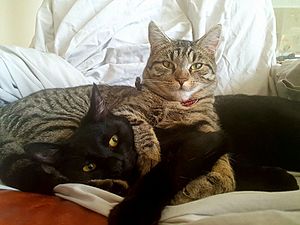
- Cats purr at a frequency between 25 and 150 Hertz. This frequency is when bones and muscles grow and repair themselves.
- Cats sweat through their paws. Because they are covered in fur, there are very few places that they can sweat. Most of their sweat glands are on their paws.
- A cat's ears are controlled by more than 20 muscles.
- The nose ridge of a cat is as unique as human fingerprints.
- Cats can filter the salt out of seawater, so they won't get dehydrated when they drink it as a human would.
- Cats (like dogs) eat grass to make themselves vomit. This gets rid of hairballs naturally.
- Cats can't taste anything sweet.
- A group of cats is called a clowder, and a group of kittens is called a kindle.
- The love of cats is called Ailurophilia.
- "Barivel," who is a Maine Coon breed is currently the longest domestic cat in the world (as of 2022), measuring 3 feet 11.2 inches (120 cm). He got this record in May of 2018.
Other Cat Pages
Images for kids
-
A cat eating a fish under a chair, a mural in an Egyptian tomb dating to the 15th century BC
-
Cat lying on rice straw
-
A domestic cat with its prey, a deermouse
-
A tabby cat in snowy weather
-
Feral farm cat
See also
 In Spanish: Felis silvestris catus para niños
In Spanish: Felis silvestris catus para niños



